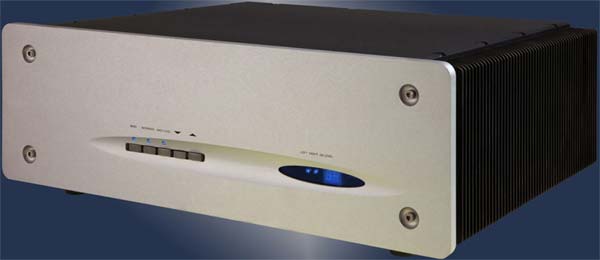Featured Article from

You Get What You Need
Phillip Holmes
No, you can’t always get what you want. The number of loudspeakers surpassing the cost of a decent family sedan is staggering. Then there are speakers that cost as much as a house. Regardless of cost, I believe all audio products need to offer a blend of good performance and decent value. Fortunately, there are some high-end speakers that offer extraordinary sound at a reasonable price. Roger Sanders’ Sanders Sound Systems 10B electrostatic hybrid is one of the few systems, and I do mean a “systemâ€, that offers outstanding value for true, high performance. Actually, considering the product’s unique capabilities and features, it’s one-of-a-kind in value for the dollar. The 10B can go toe-to-toe with speakers costing several times as much. The specs and features of the 10B are somewhat unique, especially if you have lived with ESLs of the past. The following is taken from Sanders’ website, and all the claims seem verified to me.

· The amplifier cannot damage the panel.
· No protective circuitry required.
· Panel is arc-proof.
· Extremely rugged and durable.
· Immune to dust and dirt.
· Immune to humidity.
· Repels dust.
· Unaffected by insects, dust, and foreign objects.
· Higher efficiency (98 dB efficient in the 10b speaker).
· Uses slots instead of holes.
· Highest precision – made with computerized diamond routing equipment.
· Greater percentage of open area and visual transparency.
· A modified version of the ESL Amplifier is used to drive the woofers. The power therefore increases from 200 watts/channel to 600 watts/channel.
· Both balanced and single-ended inputs and outputs are standard.
· The bass control has been split into two frequency sections so you can control the midrange and bass regions of the speaker independently of each other. This makes it possible to perfectly match the speaker to your room acoustics and personal preferences.
· An overall gain control. This is the same, sophisticated, electronic, level control used on our preamplifier. It provides one-hundred, 1 dB steps with channel matching to within 0.1 dB. This makes it possible to match the crossover to your preamplifier’s level control for optimum sensitivity. Since the system level can be controlled by the crossover, it is possible to bypass a preamplifier completely and run a single source directly to the crossover.
· The unit has a blue, digital readout that shows the level of each function similar to our preamplifier.
· All functions are available from both the front panel and by optional remote control. The remote control is so convenient that you may prefer to leave your manual preamp’s volume turned up, and control the system level with the crossover’s sophisticated, remote-control unit.
· Remote control is operated with the Sanders Sound Systems preamp’s Home Theater Master transmitter, which can be programmed to operate every component in your system. This eliminates “remote clutter†and makes system operation extremely convenient.
· Highly efficient operation permits the electronics to left on continually without concern for electricity usage.
· Speakers and Electronics are manufactured in Conifer, Colorado
· Different wood finishes [Natural Cherry, Natural Walnut, Natural Maple] are available.
I think it’s instructive to compare the 10B to another standard-bearer of value: the Magnepan 20.1. Superficially, they seem to be similar products. The 10B is a hybrid two-way electrostatic panel with a transmission line bass unit, versus the 20.1’s all dipole three-way ribbon and planar-magnetic hybrid. Sensitivity of the 10B is a surprising 98dB/watt versus an intimidating 85dB/watt for the Maggie 20.1.  What makes the 10B a completely different kind of value is the inclusion of a bass amp with built-in crossover. Active crossovers have major sonic benefits: better damping, especially from tube amps; lower distortion (harmonic, intermodulation, etc.); more efficiency; better clarity. On the downside is the extra stage of electronics.`
When comparing the two approaches, the benefits of well-built active crossovers far outweigh any veiling or distortion from the electronics. The tiny amount of added electronica is swamped by the audible affects of a complicated passive crossover with non-linear chokes, large value capacitors and mediocre resistors. In addition, passive crossovers are power hogs, robbing your amps of damping, power and dynamics. And because the 10B’s crossover also includes a 600wpc bass amplifier, it frees your existing amps of the bass, doubling or tripling their usable power. Let’s say you have a 35-watt-per-channel tube amp. For the 10B, that would be enough. A 1000-watt tube amp? Even better. The ESL panels are rated by Roger to take virtually unlimited power, which is another unique Sanders feature: the ability to rock your ass off without arc-over. Almost miraculously, these electrostatic panels are efficient and can take abuse unlike any other electrostatic panel I know.  The Maggie 20.1 will need several hundred watts, minimum, to bring them to life. I’m not disparaging the 20.1 though. It is an excellent speaker, especially if you already have huge amps. But the massive power requirements can almost double the price of the amplifier and speaker portion of your system.
The reason for the higher efficiency and reliability of the Sanders 10B, especially compared to classic ESL designs, is the use of what Sanders calls “Ultrastat†technology. It boils down to building the stators out of advanced materials, and using much improved diaphragm films. If you want a better explanation of the Ultrastat, go to Roger’s white paper:
From what I understand, this panel technology allows for closer spacing, which makes for better efficiency and high frequency extension. These panels happen to be flat, in comparison to most of the competition’s use of a curved panel. Roger takes credit for developing the curved panel, but decided to go with a flat panel which has benefits, but also a downside. (For more, read the positioning portion of this review.)
The Ultrastat panels have eliminated a dark quality that I’ve heard in most, if not all, ESLs. There is still the problem of dropping impedance with rising frequency, but the high efficiency of the 10B makes any amplifier’s job several orders of magnitude easier. A poorly-designed amp might run out of power in the highs, making them sound dark. In a reversal of fortune for amplifiers, the impedance of a stat is quite high in the bass, and gradually rises as frequency increases. It can be quite dramatic too, ranging from 50 ohms in the bass to under 2 ohms in the treble. The reason for this is that an ESL is a massive capacitor; a massive film capacitor, in this case. Capacitors present a dropping impedance with rising frequency because of something called “capacitive reactanceâ€. If you want to get into the details, check out this page. What you might hear is that a lower-powered tube amp sounding more romantic or lush, and something like Roger’s ESL amps (or a powerful tube amp) sounding flat (or flatter) in the highs.
A word of caution though: this capacitive reactance can cause problems for some transistor units, causing them to shut down, oscillate, or overheat. Some transistor amps will have a two-fold torture test: they don’t like driving high impedance loads (50 ohms in the midbass of the 10B’s panel), and they like to go nuts when trying to dump current into a 2-ohm capacitive, reactive load. If you have a 35wpc tube amp and a 35wpc transistor amp, the tube amp will sound more powerful and shouldn’t get as stressed out by the capacitive reactance. Roger has been very helpful in answering amplifier-specific questions, such as , “Has anyone used xyz brand amp with the 10B?â€
In general, a well-built, moderately-powered tube amp will loaf along driving the 10B’s panel, and perhaps compress or roll off on top when driven hard. A transistor amp with high rail voltages (high for a transistor amp), like Roger’s ESL amp, will have no problem with the 10B’s electrostatic load.
Receiving the 10B’s was a daunting experience. They come in six boxes, two for the transmission line woofers, one for the ESL panels, one for the frames and wood trim, and one for the bass amp/crossover. Additionally, I asked for, and received, the ESL stereo power amp. Incidentally, the ESL amp is one of the finest amps I’ve heard, transistor or tube; watch for a separate review. Once I got around to putting everything together, assembly was quite easy, although a total klutz might take a little guidance. If you can change your spare tire, you can assemble this speaker in 30-45 minutes. The upside to the modular construction is that shipping is much cheaper than if it were shipped in two massive boxes. This makes it an appealing product for overseas audiophiles. It also makes it a simple matter if you need to send something to Sanders to be serviced. If a panel stops working (not likely) you can ship it in a relatively compact and lightweight box. Also, it would only take 20 minutes to take the panel off of the speaker, pack it and get it loaded. Try that with a Sound Labs ESL.
Connecting the bass amp/crossover is very flexible. It includes balanced and single-ended inputs, high-pass balanced and single-ended outputs, low-pass line-level outputs in balanced and single ended, plus bass power out to the speakers. If you want, you could use the bass amp/crossover as a single-input preamp and active crossover feeding whatever amps you want to try. I liked the combination as-is, so I didn’t do a lot of amp switching. The matching ESL amp that Roger sent is a natural companion, with balanced inputs, the correct gain, and matching cosmetics.
The review system included my trusty Denon DP80 “motor unitâ€, SME V, ZYX Airy 3 cartridge, Allnic Verito cartridge, Haniwa HCTR01 cartridge, Allnic L1500 and H1500 preamp and phono stages, and multiple makes of wires.
One thing not related to sound, but something I take very seriously, is that Roger offers a lifetime transferable warranty. He also offers a 30-day audition period. The man is bending over so far backwards that his head is touching his heels. I’ve never had a more pleasant experience with a manufacturer. He even provides over-the-phone support, even on weekends.

| more… | page 2… |
| Specs: |
| Dimensions: 15″ W x 18″D x 68″ H Frequency Response: 24 Hz. to 27 KHz. +/- 2 dB Sensitivity: 98 dB/2.83 volts/meter Net Weight (assembled): 65Â lbs Shipping Weight (5 boxes): Total shipping weight 228 lbs Crossover Amplifier Dimensions: 24″ x 20″ x 12″ ESL Panel Size: 13 1/2″ x 42″ ESL Power Handling Bass Driver: 600 watts Bass Design: Transmission Line |
| About Dagogo.com |
| DAGOGO (pronounced “dah-go-go”) is a U.S. high-end audio review monthly e-magazine established since November 2003. Its mission is to present both a macroscopic and microscopic view of the high-end audio hobby to its readers. Its contents include critical commentaries, industry personality interviews, specialty show coverages and music reviews. New articles are published on the 1st and 16th of every month. www.dagogo.com |








Leave a Reply